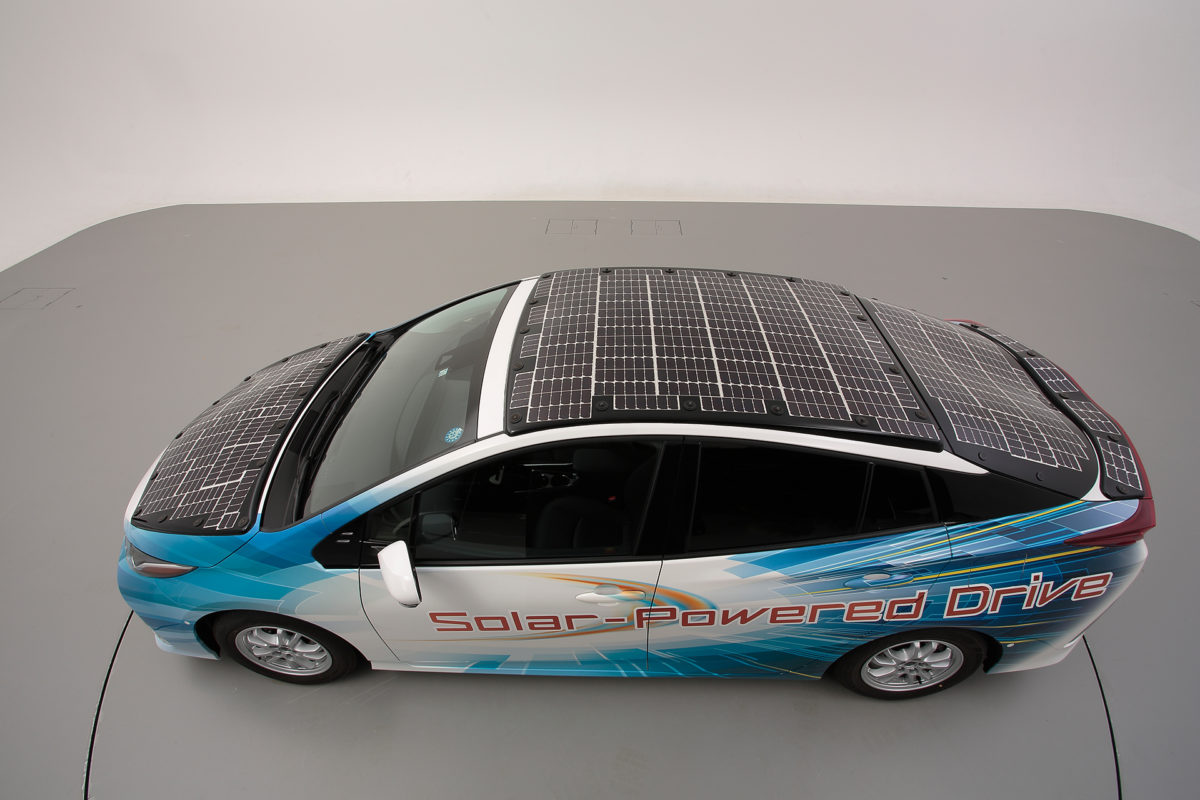Toyota has had a solar version of its Prius model since 2017, when a version was revealed which featured a small 180 W solar roof panel supplied by Kyocera. The model was only available in Japan and lacked the oomph to charge the vehicle’s battery for a range of more than 6km.
Now though, Toyota has returned to the concept and begun road testing a new generation of solar improved Prius’. This time Toyota collaborated with Sharp and the New Energy and Industrial Technology Development Organization (NEDO) for a different cell tech that purports to offer a massive 34% conversion efficiency. The cell was developed in 2016 by Toyota’s two partners. Combining indium gallium phosphide (InGaP), gallium arsenide (GaAs) and indium gallium arsenide (InGaAs) the result is a triple-junction cell.
The solar Prius of two years ago had only a small part of its roof covered with solar cells, the new version blankets the entire roof, bonnet and boot lid with high efficiency cells, resulting in a considerably higher generation output. The result can charge the vehicle battery while driving rather than just while stationary.
| Performance items | Prius PHV (solar charging system) | New demo car | |
| Solar battery cell conversion efficiency | 22.5% | 34%-plus | |
| Rated power generation output | 180 W | Approximately 860 W | |
| Maximum charge to the driving battery while the vehicle is parked (per day) | BEV-mode cruising range equivalent to 6.1km | BEV-mode cruising range equivalent to 44.5km | |
| Maximum charge and power supply to the driving and auxiliary battery while the vehicle is being driven (per day) | Supplies power only to auxiliary battery, which powers car navigation system etc. | BEV-mode cruising range equivalent to 56.3km | |
Popular content
Toyota will test the new demo car in Toyota City in Japan’s Aichi prefecture and other areas. The carmaker wants real-world data on generation output and battery charging levels to develop the onboard solar charging system further.
“Toyota plans to share a selection of trial data results with NEDO and Sharp,” said a company statement. “The PV-powered vehicle strategy committee and other entities will evaluate the benefits from improvement in the reduction of CO2 emissions and the improvement in convenience, including the number of times a vehicle requires charging. The goal is to further contribute to the creation of a new solar battery panel market, including the transport sector, and find solutions for energy and environmental issues.”
The announcement comes after Netherlands startup Lightyear announced its take on a solar powered car – the Lightyear One. While that EV boasts a 450-mile driving range its solar surface provides only 40-50 miles, outlasting the new Prius demonstration model. The Lightyear One will begin commercial production in 2021 with reservations available for 500 units. For those interested, the manufacturer’s suggested starting retail price is a casual $136,000. There are no price disclosures for the Prius as yet.
This content is protected by copyright and may not be reused. If you want to cooperate with us and would like to reuse some of our content, please contact: editors@pv-magazine.com.



If it comes to market, it will be interesting to learn how many miles of battery life it would add while sitting in a parking lot at work for 8+ hrs during a sunny day. If it could generate 10-15 miles, it might be self sufficient as a local commuter – that would be cool..
Company should develop transparent solar panels and fix them also with Windows glasses and other body. It can produce maximum electricity and will look as normal car.
Hi
Can you answer me?
How can inverters track max power?
Hello Mohammad,
Why do you need the inverter in the car?
These solar modules are for generating DC to charge the batteries and no need for power conversion.
The Tesla semi can move 80,000 lbs up to 500 miles at less than 2 kWh per mile… that means it has a battery somewhere a little south of 1000 kWh. Take that same battery and apply it to an RV with a weight of less than 26,000 lbs (max for a non-commercial vehicle) and you’d easily get over 1000 miles on a full charge. Cover said hypothetical RV in these 34% efficient solar panels and you could get at least 40 kWh per day… maybe over 100 if pull out awnings could be covered with solar and tilted to catch the sunlight better.
Even at just 40 kWh per day… minus maybe 10 to run amenities inside the RV while stationary, that’s still 30 miles worth of charge per day on a vehicle which will often sit for weeks at a time. Drive to a new park, sit for two weeks… have over 400 miles of range charged up to drive somewhere else.
Basically, an electric RV that should never need to plug in is possible with technology that already exists.